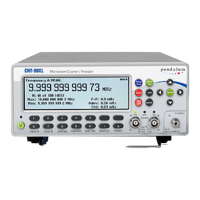Bit 5 (weight 32) — Command Error
(CME)
Shows that the instrument has detected a
command error. This means that it has re
-
ceived data that violates the syntax rules
for program messages.
Bit 4 (weight 16) — Execution Error
(EXE)
Shows that the counter detected an error
while trying to execute a command. (See
‘Error reporting’ on page 3-17.) The
command is syntactically correct, but the
counter cannot execute it, for example
because a parameter is out of range.
Bit 3 (weight 8) — Device-dependent
Error (DDE)
A device-dependent error is any device
operation that did not execute properly
because of some internal condition, for
instance error queue overflow. This bit
shows that the error was not a command,
query or execution error.
Bit 2 (weight 4) — Query Error (QYE)
The output queue control detects query er
-
rors. For example the QYE bit shows the
unterminated, interrupted, and deadlock
conditions. For more details, see ‘Error re
-
porting’ on page 3-17.
Bit 1 (weight 2)—Request Control (RQC)
Shows the controller that the device
wants to become the active control
-
ler-in-charge. Not used in this counter.
Bit 0 (weight 1) — Operation Complete
(OPC)
The counter only sets this bit TRUE in
response to the operation complete com
-
mand (*OPC). It shows that the counter
has completed all previously started ac
-
tions.
n
Summary, Standard Event
Status Reporting
*ESE <bit mask>
Enable reporting of Standard Event Sta
-
tus in the status byte.
*SRE 32
Enable SRQ when the Standard Event
structure has something to report.
ESR?
Reading and clearing the event register of
the Standard Event structure.
Using the Subsystems
Status Subsystem 6-17

